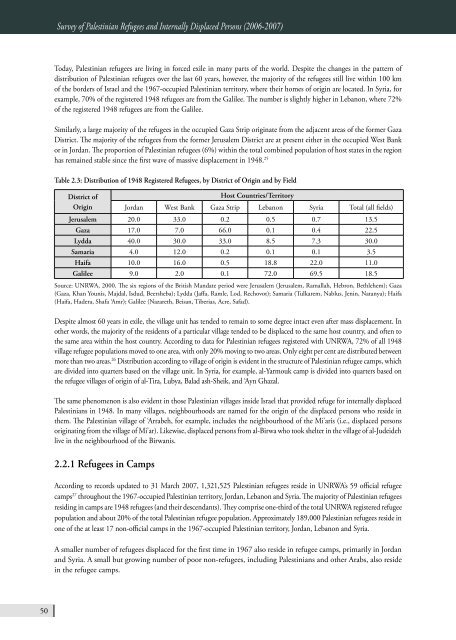BADIL Resource Center for Palestinian Residency and Refugee
BADIL Resource Center for Palestinian Residency and Refugee
BADIL Resource Center for Palestinian Residency and Refugee
Create successful ePaper yourself
Turn your PDF publications into a flip-book with our unique Google optimized e-Paper software.
50<br />
Survey of <strong>Palestinian</strong> <strong>Refugee</strong>s <strong>and</strong> Internally Displaced Persons (2006-2007)<br />
Today, <strong>Palestinian</strong> refugees are living in <strong>for</strong>ced exile in many parts of the world. Despite the changes in the pattern of<br />
distribution of <strong>Palestinian</strong> refugees over the last 60 years, however, the majority of the refugees still live within 100 km<br />
of the borders of Israel <strong>and</strong> the 1967-occupied <strong>Palestinian</strong> territory, where their homes of origin are located. In Syria, <strong>for</strong><br />
example, 70% of the registered 1948 refugees are from the Galilee. The number is slightly higher in Lebanon, where 72%<br />
of the registered 1948 refugees are from the Galilee.<br />
Similarly, a large majority of the refugees in the occupied Gaza Strip originate from the adjacent areas of the <strong>for</strong>mer Gaza<br />
District. The majority of the refugees from the <strong>for</strong>mer Jerusalem District are at present either in the occupied West Bank<br />
or in Jordan. The proportion of <strong>Palestinian</strong> refugees (6%) within the total combined population of host states in the region<br />
has remained stable since the first wave of massive displacement in 1948. 25<br />
Table 2.3: Distribution of 1948 Registered <strong>Refugee</strong>s, by District of Origin <strong>and</strong> by Field<br />
District of<br />
Origin<br />
Host Countries/Territory<br />
Jordan West Bank Gaza Strip Lebanon Syria Total (all fields)<br />
Jerusalem 20.0 33.0 0.2 0.5 0.7 13.5<br />
Gaza 17.0 7.0 66.0 0.1 0.4 22.5<br />
Lydda 40.0 30.0 33.0 8.5 7.3 30.0<br />
Samaria 4.0 12.0 0.2 0.1 0.1 3.5<br />
Haifa 10.0 16.0 0.5 18.8 22.0 11.0<br />
Galilee 9.0 2.0 0.1 72.0 69.5 18.5<br />
Source: UNRWA, 2000. The six regions of the British M<strong>and</strong>ate period were Jerusalem (Jerusalem, Ramallah, Hebron, Bethlehem); Gaza<br />
(Gaza, Khan Younis, Majdal, Isdud, Beersheba); Lydda (Jaffa, Ramle, Lod, Rechovot); Samaria (Tulkarem, Nablus, Jenin, Natanya); Haifa<br />
(Haifa, Hadera, Shafa ‘Amr); Galilee (Nazareth, Beisan, Tiberias, Acre, Safad).<br />
Despite almost 60 years in exile, the village unit has tended to remain to some degree intact even after mass displacement. In<br />
other words, the majority of the residents of a particular village tended to be displaced to the same host country, <strong>and</strong> often to<br />
the same area within the host country. According to data <strong>for</strong> <strong>Palestinian</strong> refugees registered with UNRWA, 72% of all 1948<br />
village refugee populations moved to one area, with only 20% moving to two areas. Only eight per cent are distributed between<br />
more than two areas. 26 Distribution according to village of origin is evident in the structure of <strong>Palestinian</strong> refugee camps, which<br />
are divided into quarters based on the village unit. In Syria, <strong>for</strong> example, al-Yarmouk camp is divided into quarters based on<br />
the refugee villages of origin of al-Tira, Lubya, Balad ash-Sheik, <strong>and</strong> ‘Ayn Ghazal.<br />
The same phenomenon is also evident in those <strong>Palestinian</strong> villages inside Israel that provided refuge <strong>for</strong> internally displaced<br />
<strong>Palestinian</strong>s in 1948. In many villages, neighbourhoods are named <strong>for</strong> the origin of the displaced persons who reside in<br />
them. The <strong>Palestinian</strong> village of ‘Arrabeh, <strong>for</strong> example, includes the neighbourhood of the Mi’aris (i.e., displaced persons<br />
originating from the village of Mi’ar). Likewise, displaced persons from al-Birwa who took shelter in the village of al-Judeideh<br />
live in the neighbourhood of the Birwanis.<br />
2.2.1 <strong>Refugee</strong>s in Camps<br />
According to records updated to 31 March 2007, 1,321,525 <strong>Palestinian</strong> refugees reside in UNRWA’s 59 official refugee<br />
camps 27 throughout the 1967-occupied <strong>Palestinian</strong> territory, Jordan, Lebanon <strong>and</strong> Syria. The majority of <strong>Palestinian</strong> refugees<br />
residing in camps are 1948 refugees (<strong>and</strong> their descendants). They comprise one-third of the total UNRWA registered refugee<br />
population <strong>and</strong> about 20% of the total <strong>Palestinian</strong> refugee population. Approximately 189,000 <strong>Palestinian</strong> refugees reside in<br />
one of the at least 17 non-official camps in the 1967-occupied <strong>Palestinian</strong> territory, Jordan, Lebanon <strong>and</strong> Syria.<br />
A smaller number of refugees displaced <strong>for</strong> the first time in 1967 also reside in refugee camps, primarily in Jordan<br />
<strong>and</strong> Syria. A small but growing number of poor non-refugees, including <strong>Palestinian</strong>s <strong>and</strong> other Arabs, also reside<br />
in the refugee camps.

















